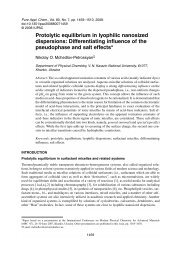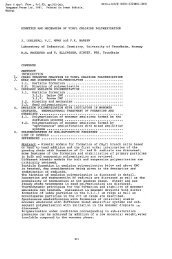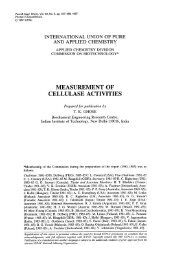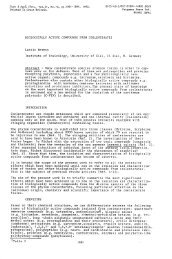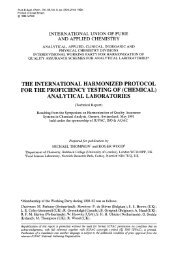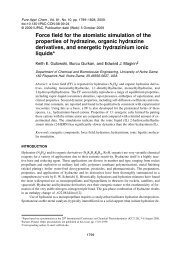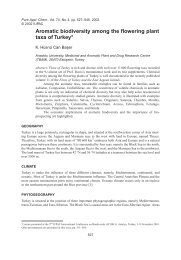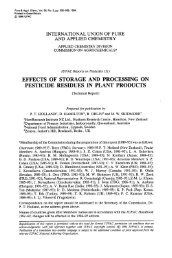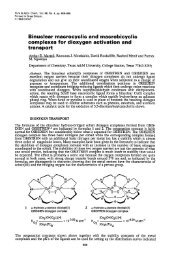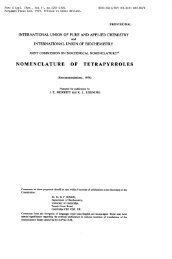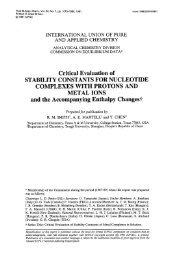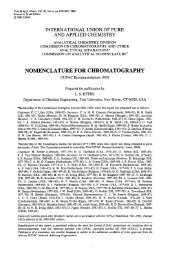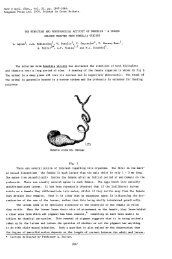Some new aspects of asymmetric catalysis with chiral ... - IUPAC
Some new aspects of asymmetric catalysis with chiral ... - IUPAC
Some new aspects of asymmetric catalysis with chiral ... - IUPAC
Create successful ePaper yourself
Turn your PDF publications into a flip-book with our unique Google optimized e-Paper software.
Pure & Appl. Chem., Vol. 70, No. 8, pp. 1477-1485, 1998.<br />
Printed in Great Britain.<br />
0 1998 <strong>IUPAC</strong><br />
<strong>Some</strong> <strong>new</strong> <strong>aspects</strong> <strong>of</strong> <strong>asymmetric</strong> <strong>catalysis</strong> <strong>with</strong><br />
<strong>chiral</strong> ferrocenyl ligands Jc<br />
Antonio Togni*, Romano Dorta, Christoph Kollner, and Giorgio Pioda<br />
Laboratory <strong>of</strong> Inorganic Chemistry, Swiss Federal Institute <strong>of</strong> Technology ETH-<br />
Zentrum, Universitatstrasse 6, CH-8092 Zurich, Switzerland<br />
Abstract: Chiral bindentate ferrocenyl ligands have been used in a variety <strong>of</strong><br />
<strong>asymmetric</strong> catalytic reactions. Three different recent developments are illustrated<br />
here. Firstly, using P, N systems containing a p-acidic phosphine and a bulky<br />
pyrazole very high enantioselectivities were obtained in the Pd-catalyzed<br />
hydrosilylation <strong>of</strong> norbornene <strong>with</strong> trichlorosilane (up to 99% ee). Secondly, selective<br />
functionalization <strong>of</strong> the "lower" Cp ring affords derivatives suited for dendrimer<br />
synthesis. Well characterized dendrimers containing up to eight peripheral Josiphos<br />
units were used in the Rh-catalyzed hydrogenation <strong>of</strong> dimethyl itaconate giving eels<br />
up to 98.6%. Finally, the enantioselective Ir-catalyzed addition <strong>of</strong> aniline to<br />
norbornene (up to 95% ee), via N-H activation, was achieved using dinuclear Ir(1)<br />
complexes as catalyst precursors.<br />
INTRODUCTION<br />
It has been previously demonstrated that <strong>chiral</strong> ligands, derived from a 1,2-disubstituted ferrocene constitute<br />
one <strong>of</strong> the most successful class <strong>of</strong> auxiliaries used in <strong>asymmetric</strong> <strong>catalysis</strong> (ref.1). Thus, ligands <strong>of</strong> the<br />
Josiphos-type (ref.2) have recently reached the stage <strong>of</strong> industrial applications. As shown in Scheme 1, a<br />
<strong>new</strong> synthesis <strong>of</strong> biotin (vitamine H) was developed at LONZA Ltd., involving the use <strong>of</strong> such ligands in a<br />
Rh-catalyzed <strong>asymmetric</strong> hydrogenation reaction <strong>of</strong> a fully substituted C-C double bond (ref.3). Moreover,<br />
what appears to be the largest-scale industrial application <strong>of</strong> <strong>asymmetric</strong> <strong>catalysis</strong> so far, is an Ir-catalyzed<br />
imine reduction that makes use <strong>of</strong> a ferrocenyl diphosphine for the synthesis <strong>of</strong> the herbicide (S)-Metolachlor<br />
at Novartis Ltd. (ref.4).<br />
0.2 mol Yo Rh<br />
L'<br />
____)<br />
H2<br />
0<br />
80 % ee<br />
- (+)-Biotin<br />
4<br />
90 % ee (R = CH2Ph)<br />
SMetolachlor<br />
(Herbicide)<br />
Scheme 1. Examples <strong>of</strong> production-scale applications <strong>of</strong> ferrocenyl diphosphinc<br />
The modular synthetic approach to this kind <strong>of</strong> ligands represents one <strong>of</strong> their most important and unique<br />
features. Indeed, it is possible to readily vary the nature <strong>of</strong> the two ligating fragments L' and L2 attached to<br />
the 1-ferrocenylethyl backbone by a two-step procedure, starting from a common precursor (see Scheme 2).<br />
*Plenary lecture presented at the 12th International Conference on Organic Synthesis, Venice, 28 June-2 July 1998.<br />
Other presentations are published in this issue, pp. 1449-1512.<br />
1477
1478 A. TOGNI eta/.<br />
L' and L2 are typically phosphino and/or pyrazolyl fragments. Thus, the opportunity is given to<br />
expeditiously fine-tune both the steric and electronic properties <strong>of</strong> the ligands, according to the needs <strong>of</strong> a<br />
particular reaction, <strong>with</strong> a particular substrate.<br />
synt hon)<br />
Ligand fragment 2<br />
(ac hi ral<br />
Common ferrocene fragment<br />
(carrier <strong>of</strong> the <strong>chiral</strong> information)<br />
Scheme 2. General strategy for the synthesis <strong>of</strong> <strong>new</strong> ferrocenyl ligands bearing two different ligand fragments L' and L2<br />
Examples <strong>of</strong> ligands that have been recently prepared following this strategy and that were successfully<br />
applied in <strong>asymmetric</strong> reactions, such as Rh-catalyzed hydroboration <strong>of</strong> olefins (refS), Pd-catalyzed allylic<br />
amination (ref.6), hydrosilylation (ref.7), Heck-reactions (ref.8), Ir-catalyzed olefin hydroamination (ref.9),<br />
etc., are shown in Scheme 3.<br />
Scheme 3. Examples <strong>of</strong> fcrroccnyl ligands bearing a varicty <strong>of</strong> phosphino- and pyrazolyl fragments.<br />
Pd-CATALYZED HYDROSTLYLATION OF OLEFINS<br />
We have previously shown that P,N-ferrocenyl ligands may be easily tuned in both a steric and electronic<br />
manner, in order to achieve optimum stereoselectivities. We recently found that such ligands are suitable<br />
auxiliaries in the Pd-catalyzed hydrosilylation <strong>of</strong> olefins <strong>with</strong> trichlorosilane (ref. 10). As shown in Scheme<br />
4, a relatively brief, empirical screening <strong>of</strong> ligand structures allowed us to achieve an enantioselectivity <strong>of</strong><br />
99% ee for the model olefin norbornene.<br />
The representative ligand series <strong>of</strong> Scheme 4, clearly shows that this particular reaction requires a relatively<br />
large substituent at position 3 <strong>of</strong> the pyrazolyl fragment. In the present case, the best substituent appears to<br />
be 2,4,6-trimethylphenyl. Furthermore, the replacement <strong>of</strong> the unsubstituted phenyls at the phosphorus atom<br />
by 3,5-bis(trifluoromethyl)phenyl groups, i.e., by increasing the n-acidity <strong>of</strong> the phosphine, led to the<br />
ligand affording the highest known enantioselectivity for this hydrosilylation. This is an illustration that the<br />
steric optimization <strong>of</strong> the ligand should be followed by a corresponding electronic fine-tuning, best achieved<br />
0 1998 <strong>IUPAC</strong>, Pure &Applied Chernistry70, 1477-1485
Asymmetric <strong>catalysis</strong> wifh <strong>chiral</strong> ferrocen yl ligands 1479<br />
by the introduction and/or a variation <strong>of</strong> peripheral substituents, in terms <strong>of</strong> their electron-<strong>with</strong>drawing or<br />
donating properties.<br />
1) HSiC13<br />
0.1 mot o/o PdCML')<br />
2) Oxidative Workup<br />
d 39%ee d 76%ee 82%ee<br />
.Me<br />
Scheme 4. Stcric and electronic tuning <strong>of</strong> P,N-lcrrocenyl ligands for the Pd-catalyzed hydrosilylation<br />
<strong>of</strong> norbomcnc <strong>with</strong> wichlorosilane.<br />
For this Pd-catalyzed hydrosilylation important electronic effects exerted by the substrate olefin have also<br />
been observed. As shown in Scheme 5, the pura-substituents in styrenes were found to affect the<br />
enantioselectivity <strong>of</strong> the reaction in a very important manner. Thus, electron-<strong>with</strong>drawing and electron-<br />
donating groups, respectively, lead to the formation <strong>of</strong> opposite product enantiomers. Furthermore, the<br />
correlation <strong>of</strong> log[(S)/(R)] <strong>with</strong> op + indicates the development <strong>of</strong> a positive charge in the transition state <strong>of</strong><br />
the enantio-selectivity-determining step, thus suggesting that after hydride insertion and before the formation<br />
<strong>of</strong> the carbon-silicon bond, the benzyl ligand is coordinated in an q3 mode (allylic). This is an important<br />
piece <strong>of</strong> information for a reaction for which a detailed mechanistic understanding is still lacking.<br />
THE DEVELOPMENT OF DENDRITIC CATALYST SYSTEMS.<br />
Because <strong>of</strong> the proven efficacy <strong>of</strong> <strong>chiral</strong> ferrocenyl ligands in a number <strong>of</strong> <strong>asymmetric</strong> reactions, we set up a<br />
study aimed at creating dendrimers which carry catalytically active units at their periphery (ref. 11). Thus,<br />
combining several, otherwise independent catalysts into one single nanoscopic particle, several advantages<br />
related to the properties <strong>of</strong> such macromolecules could be envisaged. Catalytically active dendrimers, in<br />
particular if they contain cationic transition metal complexes should be less soluble than their monomeric<br />
counterpart. Recovery by selective precipitation may thus be an opportunity. Furthermore, due to their size,<br />
these materials are amenable to ultrafiltration methods (membrane reactor).<br />
For the incorporation <strong>of</strong> ferrocenyl ligands into dendritic structures a functionalization is required. The<br />
choice <strong>of</strong> the point <strong>of</strong> attachment <strong>of</strong> the spacer on the ferrocenyl ligand molecule is <strong>of</strong> great potential<br />
importance. From a synthetic point <strong>of</strong> view, different anchoring points may entail different, more or less<br />
complex synthetic routes. From a structural point <strong>of</strong> view, location and length <strong>of</strong> the spacer may influence<br />
0 1998 <strong>IUPAC</strong>, Pure &Applied Chemistry70, 1477-1485
1480 A. TOGNI eta/.<br />
catalyst performance, by virtue <strong>of</strong> intramolecular interactions. Scheme 6 illustrates this general idea and gives<br />
the structure <strong>of</strong> the currently used intermediates according to their anchoring strategy.<br />
0.5-<br />
2) Oxidation<br />
X X<br />
-1 I I I I<br />
-2 -1.5 -1 -0.5 0 0. 5<br />
OP+<br />
X=CI; 67% ee (S)<br />
X=NMe,; 64% ee (R)<br />
Scheme 5. Linear free-encrgy relationship [or the hydrosilylation <strong>of</strong> p-substituted styrenes<br />
Anchoring modes<br />
Remote eQ Fe<br />
4P<br />
4P<br />
"Ligand" (n=l-3)<br />
M e 2 \ S i 4<br />
"Vi ci n al" "Remote"<br />
Scheme 6. Illustration <strong>of</strong> thc different anchoring modcs Tor fcrroccnyl ligands to dcndrimcrs. The thrce specific compounds<br />
shown arc currcntly bcing uscd for thc synthesis <strong>of</strong> GO, G 1, and G2 dcndrimcrs.<br />
0 1998 <strong>IUPAC</strong>, Pure &Applied Chemistry70, 1477-1485
Asymmetric <strong>catalysis</strong> <strong>with</strong> <strong>chiral</strong> ferrocenyl ligands 1481<br />
The derivatives depicted in Scheme 6 are accessible in three, four, and six steps, respectively, from the<br />
common, enantiomerically pure starting material (R or S)-N,N-dimethyl- 1 -ferrocenyl ethylamine in moderate<br />
to good overall yields. The remote anchoring mode intuitively appears to be the best suited because <strong>of</strong> the<br />
minimized intramolecular steric interactions between ligand fragments and linker. Thus, using the<br />
corresponding intermediate the so far largest dendrimers <strong>of</strong> this type containing six or eight Josiphos units<br />
has been prepared, as illustrated in Scheme 7, in good yields and in gram quantities. The core <strong>of</strong> the<br />
dendrimers is constituted in these two cases by a 1,3,5-trisubstituted benzene ring and by a 1,3,5,7tetrasubstituted<br />
adamantane, respectively. By way <strong>of</strong> example, the discussion shall be focussed on these two<br />
derivatives only. As one would expect, in the 31P NMR spectra only one pair <strong>of</strong> doublets is observed, <strong>with</strong><br />
the typical long range 4Jpp coupling constant <strong>of</strong> ca. 34 to 37 Hz. This indicates the equivalence <strong>of</strong> the<br />
ferrocenyl units. However, broad signals in the ’H NMR 300 MHz spectra are observed at room<br />
temperature, possibly indicating slow conformational equilibria in the sterically rather crowded inner core <strong>of</strong><br />
the dendrimers.<br />
TPh2 PCY2<br />
1) oy<br />
OTBDMS<br />
NEt, /CH2C12<br />
93%<br />
2) Bu,NF/THF<br />
99%<br />
*<br />
NEt, /Toluene<br />
85%<br />
J<br />
w I<br />
OH<br />
/ COCl<br />
Scheme 7. Typical convergcnt synthcsis <strong>of</strong> Josiphos-conmining dendrimcr.<br />
Nonetheless, well resolved spectra for these two compounds are obtained when corresponding DMSO-d6<br />
solutions are measured at 80°C and 1 20°C, respectively. The <strong>new</strong> high-molecular-weight compounds were<br />
also characterized by MALDI-TOF mass spectrometry. Molecular peaks at m/z values in very good<br />
agreement <strong>with</strong> the calculated ones, as well as in-source fragmentation (ref.12) patterns very similar to those<br />
0 1998 <strong>IUPAC</strong>, Pure &Applied Chemistry70, 1477-1485
1482 A. TOGNI eta/.<br />
<strong>of</strong> the ,,monomeric" counterpart Josiphos under EI conditions were observed. Sections <strong>of</strong> such MALDI-TOF<br />
spectra are illustrated in Figure 1.<br />
I l l I I<br />
I 4400 490C<br />
....<br />
6000 6500<br />
Fig. 1 Sections <strong>of</strong> the MALDI-TOF mass spectra <strong>of</strong> dendrimers containing six (A) and eight (B) Josiphios units, showing<br />
typical in-source fragmentation patterns (calculated molecular mass = 4853.15 and 6502.95, respectively).<br />
In order to gain insight as to the behavior <strong>of</strong> the <strong>new</strong> dendritic ligands in catalytic reactions, the simple Rh-<br />
catalyzed <strong>asymmetric</strong> hydrogenation <strong>of</strong> dimethyl itaconate in MeOH was chosen as a standard reaction for<br />
comparing their performances. In situ catalyst preparation was attained by mixing the ligand (1 eq / number<br />
<strong>of</strong> ferrocenyl units) <strong>with</strong> 1 eq <strong>of</strong> [Rh(COD)2]BF4 in CH2C12 and stirring for 15 min under Ar. The orange<br />
solid obtained after evaporation <strong>of</strong> the solvent was used as a catalyst precursor. P NMR spectra <strong>of</strong> these<br />
materials showed a single AMX spin-system, as expected when all ferrocenyl sites are bonded to Rh.<br />
Hydrogenation experiments performed using 1 mol% Rh under 1 bar <strong>of</strong> hydrogen pressure, as previously<br />
reported(ref.2a), gave very similar results. In all cases hydrogen take-up ceased after ca. 20 min, and<br />
substrate was no longer detectable. The enantioselectivities afforded by the dendritic catalysts (between<br />
98.0% ee and 98.6% ee) are only slightly lower than that obtained using the corresponding mononuclear<br />
Josiphos catalyst (99.0% ee). However, a weak trend to lower enantioselectivities seems to parallel the<br />
increasing size <strong>of</strong> the dendritic ligands.<br />
The synthetic strategy illustrated in Scheme 7 implies an intrinsic limitation, since it starts from the complete<br />
functionalized ligand Josiphos. For a wider scope <strong>of</strong> application, one would like to modify the ligand<br />
fragments according to the needs <strong>of</strong> a specific reaction. From this point <strong>of</strong> view it is desirable to complete the<br />
ligand synthesis after assembling the dendrimer. Thus, a PPFA derivative, still containing a dimethylamino<br />
group amenable to nucleophilic substitution reactions (Scheme 6) , has been prepared and incorporated into a<br />
GO dendrimer. In order to test the possibility <strong>of</strong> a multiple functionalization, the preparation <strong>of</strong> a P,N-ligand<br />
system has been achieved in the last syntetic step, as (Scheme 8). We are currently exploiting compounds <strong>of</strong><br />
the type shown in Scheme 8, however <strong>of</strong> higher dendrimer generation for the preparation <strong>of</strong> ligands having<br />
different combinations <strong>of</strong> donor fragments (both P,P and P,N).<br />
THE DEVELOPMENT OF CATALYTIC ASYMMETRIC HYDROAMINATION OF<br />
OLEFINS<br />
Despite its synthetic potential and practical relevance, the <strong>asymmetric</strong> catalytic olefin hydroamination is still<br />
an undeveloped reaction. Indeed, besides the lanthanide-catalyzed enantioselective olefin hydroamination /<br />
cyclization reported by Marks and co-workers (ref. 13), to the best <strong>of</strong> our knowledge no intermolecular<br />
version <strong>of</strong> this reaction is known. So far, transition metal catalysts for the intermolecular hydroamination <strong>of</strong><br />
unactivated olefins hardly afford turnover numbers <strong>of</strong> more than ca. 0.08 h-' at 1 atm and medium<br />
31<br />
0 1998 <strong>IUPAC</strong>, Pure &Applied Chemistry 70, 1477-1485
Asymmetric <strong>catalysis</strong> <strong>with</strong> <strong>chiral</strong> ferrocenyl ligands<br />
temperature (ref. 14). Organo-f-element complexes are able to catalyze the same reaction <strong>of</strong> unactivated<br />
olefins, such as 1-pentene, at a rate <strong>of</strong> up to NI 0.4 h" at 6OoC (ref.13b).<br />
mMe2<br />
Me2< NH, 83%<br />
\<br />
Scheme 8. Multiplc functionalization <strong>of</strong> a GO dendrimcr as the final step in the prcparation <strong>of</strong> a P,N-ligand.<br />
The feasibility <strong>of</strong> catalytic hydroamination via N-H activation has been demonstrated previously (ref. 14a). In<br />
particular, it was shown that the electron-rich Ir complex [Ir(PEt&(C2H4)Cl] cleanly oxidatively adds<br />
aniline. The Ir(II1) hydrido amido species thus formed undergoes insertion <strong>of</strong> norbornene leading to a well<br />
characterized complex containing a chelating alkylamino ligand, from which the amination product is<br />
released upon reductive elimination. However, this system did not afford more than up to six turnovers in<br />
catalytic experiments, in the presence <strong>of</strong> apparently beneficial Lewis acids such as ZnC12.<br />
( R=C y , [ I rC I ( ( R)- ( S) - J 0s i p h 0s )I2 )<br />
(R=Ph)<br />
(R=CY)<br />
(R=Ph)<br />
Me<br />
( R=3,5-Me2Ph) ( R=3,5-Me2Ph)<br />
Scheme 9. The ncw dinuclear Ir(1) complexcs used as catalyst precursors in the <strong>asymmetric</strong> addition <strong>of</strong> aniline to norbornene.<br />
0 1998 <strong>IUPAC</strong>, Pure &Applied Chemistry 70, 1477-1485<br />
1483
I 484 A. TOGNI eta/<br />
We found that [IrC1(C2H&], or [IrCl(COE)2]2 smoothly reacts <strong>with</strong> Josiphos-type ligands and <strong>with</strong> the axial<br />
<strong>chiral</strong> auxiliaries BINAP and Biphemp, respectively, in toluene solution, affording in good yields the <strong>new</strong><br />
dinuclear derivatives shown in Scheme 9. The ferrocenyl derivatives were isolated as an inseparable mixture<br />
<strong>of</strong> cis/trans isomers (ref.9).<br />
The complexes shown in Scheme 9 were used as catalyst precursors in the model hydroamination <strong>of</strong><br />
norbomene <strong>with</strong> aniline. The reactions were performed <strong>with</strong>out solvent and <strong>with</strong> a catalyst concentration <strong>of</strong> 1<br />
or 2 mol% Ir. First experiments, performed <strong>with</strong> the (R)-(S)-Josiphos complexes at 5O0C, have shown the<br />
clean but slow formation <strong>of</strong> exo-(2-phenylamino)norbornane in 5 1 o/o ee (29, accompanied by traces <strong>of</strong> the<br />
corresponding endo-isomer (ca. 15% conversion in 3d). We reasoned that the good Tc-donating properties <strong>of</strong><br />
fluoride as a ligand, together <strong>with</strong> its tendency to form hydrogen bridges, could enhance the propensity<br />
towards N-H oxidative addition. However, we were not able so far to prepare the fluoro analogues <strong>of</strong> any <strong>of</strong><br />
the complexes used as catalysts precursors. Nevertheless, both activity and enantioselectivity benefited from<br />
the addition <strong>of</strong> co-catalytic amounts <strong>of</strong> ,,naked" fluoride, added as a benzene solution <strong>of</strong> phosphazeniumfluoride-P2.<br />
For all catalysts used the addition <strong>of</strong> fluoride (0.5 to 4 eq per Ir) led to both an increase <strong>of</strong><br />
activity and significantly higher enantioselectivity. Under the cocatalytic activity <strong>of</strong> fluoride it was possible to<br />
obtain the so far highest enantioselectivities for this kind <strong>of</strong> transfomiation, using BINAP as <strong>chiral</strong> ligand. A<br />
selection <strong>of</strong> results is shown in Scheme 10.<br />
Fluoride added as:<br />
(R)-(S)-Josiphos Q 60'10 ee (R)<br />
(R)-(9-Josiphos e 51'10 ee (6'<br />
no fluoride<br />
NMe, (R)-Biphemp Q 92% ee (5)<br />
(S)-BINAP Q 95% ee (R)<br />
(9-BINAP e 57% ee (R)<br />
no fluoride<br />
Scheme 10. Somc examples <strong>of</strong> <strong>asymmetric</strong> Ir-catalyzed addition <strong>of</strong> anilinc to norborncnc using diffcrcnt <strong>chiral</strong> ligands, and<br />
<strong>with</strong> and <strong>with</strong>out cocatalytic fluoride.<br />
Ir(l)-Fluoro complex can<br />
bind amine via hydrogen bridge<br />
H Formation <strong>of</strong> an<br />
Ir( Ill)-amido( hydrido) complex<br />
Formation <strong>of</strong> an Ir(I)<br />
HF-adduct<br />
Scheme 11. A speculative role <strong>of</strong> fluoride in the Ir-catalyzed hydroamination <strong>of</strong> olefins, postulating the formation <strong>of</strong> reactive<br />
Ir fluoridc complcxcs.<br />
Due to the high basicity <strong>of</strong> the ,,naked" fluoride anion, anilide could be produced by deprotonation <strong>of</strong> aniline.<br />
It has been shown that addition <strong>of</strong> LiNHPh is necessarv to uromote the condensation <strong>of</strong> aniline <strong>with</strong><br />
0 1998 <strong>IUPAC</strong>, Pure &Applied Chemistry 70, 1477-1485
Asymmetric <strong>catalysis</strong> <strong>with</strong> <strong>chiral</strong> ferrocenyl ligands 1485<br />
norbornene when a rhodium catalyst is used (ref.l4b,c). However, when one eq <strong>of</strong> LiNHPh per Ir was<br />
added to the catalyst, instead <strong>of</strong> fluoride, all the activity was lost. Furthermore, anilido-bridged Ir(1)<br />
complexes were prepared and characterized and shown not to posses any catalytic activity (ref.15). From<br />
these experiments we conclude that fluoride is likely to behave as a ligand, replacing chloride in the<br />
coordination sphere <strong>of</strong> Ir. The precise role <strong>of</strong> fluoride in enhancing both activity and selectivity is so far still<br />
a matter <strong>of</strong> speculation. Given that this anion is acting as a ligand, the fomiation <strong>of</strong> a hydrogen bridge to<br />
aniline would contribute in activating the N-H bond and at the same time in predetermining the relative<br />
orientation <strong>of</strong> the aniline molecule in the coordination sphere <strong>of</strong> Iridium. A schematic representation <strong>of</strong> the<br />
possible elementary processes leading to the formation <strong>of</strong> Ir(II1) complexes containing fluoro, hydrido, and<br />
amido ligands is shown in Scheme 11. At the Ir(II1) stage and after olefin insertion into the Ir-N bond, the<br />
lability <strong>of</strong> the fluoro ligand and hence the rapid dissociation <strong>of</strong> F- could accelerate the final step in the<br />
catalytic cycle, i.e., the reductive elimination <strong>of</strong> the product.<br />
CONCLUSION<br />
We have shown that <strong>chiral</strong> ferrocenyl ligands derived from 1,2-disubstituted ferrocenens, by virtue <strong>of</strong> their<br />
modular synthetic approach, may be adapted successfully to several types <strong>of</strong> transition-metal catalyzed<br />
<strong>asymmetric</strong> reactions, thus affording very high stereoselectivities. Moreover, the possibility to further<br />
functionalize such ligands <strong>of</strong>fers the opportunity to incorporate them into dendritic structures. The<br />
development <strong>of</strong> the <strong>asymmetric</strong> hydroamination <strong>of</strong> olefins, still very much in its infancy, has shown how<br />
important the effect <strong>of</strong> additives may be. In particular, fluoride is an anion whose possible role in catalytic<br />
processes has rather been neglected so far.<br />
1.<br />
2.<br />
3.<br />
4.<br />
5.<br />
6.<br />
7.<br />
8.<br />
9.<br />
10.<br />
11.<br />
12<br />
13<br />
14<br />
15<br />
REFERENCES<br />
For a review, see: a) T. Hayashi In FERROCENES: Ilomogeneous Catalysis, Organic Synthesis, Materials Science,<br />
A. Togni and T. Hayashi, Eds., VCH, Wcinheim (New York), 105-142 (1995) and rcfcrcnces cited therein. First<br />
report: b) T. Hayashi, K. Yamamoto and K. Kumada, Tetrahedron Lett. 4405 (1974). For rcccnt reviews , see: c) A.<br />
Togni, Chimia 50, 86 (1996). d) A. Togni, Angew. Chem. 108, 1581 (1996) (Angew. Chem. In(. Ed. Engl. 35,<br />
1475 (1996).<br />
a) A. Togni, C. Brcutel, A. Schnydcr, F. Spindlcr, H. Landcrt and A. Tijani, J. Am. Chem. Sac. 116,4062 (1994).<br />
b) U. Burckhardt, L. Hintcrmann, A. Schnydcr and A. Togni, Organometullics 14,5415 (1995).<br />
J. McGarrity, F. Spindlcr, R. Fuchs and M. Eycr, Eur. Pat. Appl. EP 624 587 A2, (LONZA AG), Chem. Abstr.<br />
122, P81369q (1995).<br />
For an account about thc succcssful dcvclopmcnt <strong>of</strong> this process, see: F. Spindlcr, B. Pugin, H.-P. Jalctt, H.-P. Buser,<br />
U. Pittclkow and H.-U. Blascr, In "Catalysis <strong>of</strong> Organic Reactions", R.E. Malz, Jr., Ed. (Chem. Ind. Vol. 68,<br />
Dckkcr, New York, 153-166 (1996).<br />
a) A. Schnydcr, L. Hintermann and A. Togni, Angew. Chem. 107, 996 (1995) (Angew. Chem. Int. Ed. EngL 34,<br />
931 (1995). b) A. Schnydcr, A. Togni and U. Wicsli, Organometallics, 16, 255 (1997).<br />
A. Togni, U. Burckhardt, V. Gramlich, P. S. Prcgosin and R. Salzmann, J. Am. Chem. Sot. 118, 1031 (1996).<br />
G. Pioda and A. Togni, to be published<br />
M. Baumann and A. Togni, to bc published.<br />
R. Dorm, P. Egli, F. Zurchcr and A. Togni J . Am. Chem. Soc. 119, 10857 (1997).<br />
For olhcr successful applications <strong>of</strong> <strong>asymmetric</strong> hydrosilylation, scc: a) T. Hayashi, Asymmetric Reactions Catalyzed<br />
by Palladium-MOP Complexes in Organic Synthesis via Organometallics OSM 5, G. Hclmchcn, J. Dibo, D.<br />
Flubachcr and B. Wiesc, (Eds.), Vicwcg, Braunschwcig/Wicsbadcn, (1997) b) Y. Uozomi, S.Y. Lee and T. Hayashi,<br />
Tetrahedron Lelt. 33,7185 (1992). c) Y. Uozomi, K. Kitayama, T. HayashiTetrahedron: Asymmetry 4,2419 (1993).<br />
d) Y. Uozomi, T. Hayashi Tetrahedron Leu. 34,2335 (1993). e) T. Hayashi Acra Chem. Scand. 50,259 (1996).<br />
For previous reports, see: a) J.W.J. Knapen, A.W. van dcr Made, J.C. dc Wilde, P.W.N.M. Leeuwen, P. Wijkens,<br />
D.M. Grove and G. van Kotcn, Nature 372,659 (1994). b) D. Scebach, R.E. Marti and T. Hintermann, Helv. Cliim.<br />
Acla 79, 1710 (1996). c) P.B. Rhcincr, H. Scllncr and D. Sccbach, Helv. Chim. Acta 80, 2027 (1997). d) C. Bolm,<br />
N. Derricn and A. Scger, Synlett 387 (1996). c) H. Brunner, J. Organomel. Chem. 500, 39 (1995).<br />
For cxamplcs <strong>of</strong> mass spectrometric charactcrization <strong>of</strong> dcndrimcrs, see, c.g.: a) J.C. Hummclcn, J.L.J. van Dongen<br />
and E.W. Mcijer, Chem. Eur. J. 3, 1489 (1997). b) K.L. Walkcr, M.S. Kahr, C.L. Wilkins, 2. Xu and J.S. Moore,<br />
J. Am. Soc. Mass Spectrom. 5, 731 (1994). c) For a discussion <strong>of</strong> in-sourcc fragmcntations in MALDI MS, see:<br />
D.C. Rcibcr, T.A. Grover and R.S. Brown, Anal. Chem. 70, 673 (1998), and rcfcrcnccs citcd thcrcin.<br />
See, e.g.; a) M.A. Giardcllo, V.P. Conticello, L. Brard, M.R. Gagn6 and T.J. Marks, J. Am. Chem. Soc. 116,<br />
10241 (1994). b) Y. Li and T.J. Marks, Organometallics 15, 3770 (1996). c) Y. Li and T.J. Marks, J. Am. Chern.<br />
Sot. 118, 9295 (1996). and furthcr rckrcnccs citcd thcrcin.<br />
a) A.L. Casalnuovo, J.C. Calabrcsc and D. Milstein, J. Am. Chem. Soc. 110, 6738 (1988) b) J.-J- Brunet, D.<br />
Ncibcckcr and K. Philippot, J. Chem. SOC. Chem. Commun. 1215 (1992). c) J.-J. Brunct, G. Commenges, D.<br />
Ncibcckcr and K. Philippot, .I. Organornet. Chem. 469, 221(1994). For rccent reviews, scc, c.g.: d) J.-J. Brunct,<br />
Gazz. Chim. Ilul. 127, 111 (1997). c) D.M. Roundhill, Catalysis Today 37, 155 (1997).<br />
R.Dorta and A. Togni, to bc published.<br />
0 1998 <strong>IUPAC</strong>, Pure &Applied Chemistry70, 1477-1485



